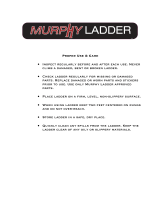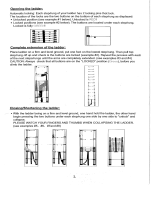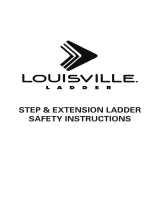
FIBERGLASS LADDER TECHNICAL MANUAL
12
7.9.5 Material Properties – Weathering. The mechanical properties of web coupon
specimens prepared from the weathered samples shall meet the values established in Table 2 after
1000 hours of exposure to the weathering cycle. Further information concerning
weathering is given in 7.9.5.1 through 7.9.5.3.
7.9.5.1 Accelerated Weathering Test Procedures. As a means of determining the
weathering characteristics of newly manufactured fiberglass-reinforced plastic ladders, both outdoor
and artificial weathering test may be employed. The different types of accelerated exposure devices
used may include but are not limited to, the following:
(1) Fluorescent ultraviolet (UV) and condensation apparatus, as outlined in American
National Standard Recommended Practice for Operating Light- and Water-Exposure
Apparatus (Fluorescent UV-Condensation Type) for Exposure of Nonmetallic Materials.
ANSI/ASTM G53-94, to simulate the deterioration caused by sunlight and water as rain
or dew. This tester is preferred, particularly if a cycle of 6 hours of ultraviolet exposure
at 130°F followed by 6 hours of condensation at 100°F is used.
NOTE: For example, Q-U-V Cyclic Ultra-Violet Weathering Tester (available from the
Q-Panel Company, 15610 Industrial Parkway, Cleveland, Ohio 44135), or the equivalent.
(2) Carbon-arc devices as outlined in ASTM G23-93, Recommended Practice for Operating
Light- and Water-Exposure Apparatus (Carbon-Arc Type) for Exposure of Nonmetallic
Materials, using distilled or ionized water in the water spray cycle; the requirements of
American National Standard Practice for Operating Light- and Water-Exposure Apparatus
(Carbon-Arc Type) for Exposure of Plastics, ANSI/ASTM D1499-92A, should also be met.
NOTE: For example, Sunshine or Twin Carbon Arc, or the equivalent.
(3) Xenon-arc-type devices as outlined in American National Standard Recommended
Practice for Operating Xenon-Arc-Type (Water Cooled) Light- and Water-Exposure
Apparatus for Exposure of Plastics, ANSI/ASTM D2565-92A, and American
National Standard Recommended Practice for Operating Light-Exposure Apparatus (Xenon-Arc
Type) with and without Water for Exposure of Nonmetallic Materials, ANSI/ASTMG26-94,
using
distilled or deionized water in the water spray cycle.
In either of the methods given in (2) and (3), the cycle should consist of the following: 102
minutes
light only, black-panel temperature 145°F±9°F during light-only cycle; 18 minutes
light and spray, relative humidity 50%±5%, black-panel temperature 100°F±10°F during light and
spray; ozone, 5 parts per hundred million (optional).
(4) An accelerated device, utilizing an equatorial mount with mirrors for acceleration and
water spray, may be used after correlation with one of the artificial weathering devices.
NOTE: For example, EMMAQUA Accelerated Outdoor Weathering Device (available from
Desert Sunshine Exposure Test, Inc., Box 185, Black Canyon Stage, Phoenix, AZ 85020), or the
equivalent.
7.10 Electrical Properties. The electrical properties of the reinforced plastic materials shall be
determined at the time of manufacture.
NOTE: These tests do not reflect the electrical properties of reinforced plastic ladders owning to
the wide variety of reinforced plastic composites, metals, and design possibilities employed in
their construction. Consequently, these requirements refer only to the reinforced plastic rail.
However, ladders constructed of reinforced plastic rails and metal rungs or steps are designed for
use in certain electrical applications.
7.10.1 AC Dielectric Strength. A full section of 1-inch length of the rail material, as received, shall
have a dielectric strength of at least 25,000 volts as determined by the
short-time test method given in ASTM D149-94, Test for Dielectric Breakdown Voltage and Dielectric
Strength of Electrical Insulating Materials as Commercial Power Frequencies, and ASTM D229-91,
which uses the parallel plane-to-plane method in oil, modified as follows: The full-section specimens
with parallel ends shall be placed edgewise between parallel circular disc flat electrodes. These
opposing cylinders should be at least 5 inches in diameter, 1 inch thick, with edges rounded to a
0.25-inch radius. The disc shall extend a minimum of 1/2 inch beyond the largest specimen dimension.
Ten specimens shall be included in the average.
Special attention should be given to the cleanliness, dryness, and temperature of the transformer oil
used. Dibutyl phthalate is a satisfactory substitute for transformer oil. Either material should be periodi-
cally evaluated using ASTM D1816-84A (1990). Test for Dielectric Breakdown Voltage of Insulating Oils
of Petroleum Origin Using VDE Electrodes.























